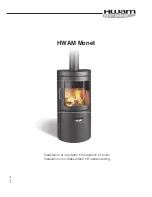
10
7.4
FILTER KIT
A louvered rear panel is the standard air inlet configuration for the MicoFlame series 2. A filter
kit is available. The filter is washable and accounts for an additional pressure loss of less than
0.05” W.C. Highly recommended for dusty environments.
The filter kit can also be provided when using the outdoor air kit.
7.5
STANDARD VENTING
The MicoFlame series 2 is a category 1 appliance and is approved for venting into a common
standard chimney. If chimney height is much greater than 30 feet or if drafts are excessive, it
may be preferable to provide a single acting barometric damper directly above the vent collar.
This damper will ensure smooth light off and minimize standby loss through the boiler. Be sure
to position the damper at least 6 “ away from the wall of the vent connector.
7.6
VENTING FOR CONDENSING APPLICATION
When supplied with the optional condensing cartridge, the MicoFlame series 2 is 95% efficient
(category II or IV appliance) which requires the use of special venting system. Refer to
installation instruction No. 93-0152-1. Only venting components listed by a nationally recognized
testing agency may be used.
8. RELIEF VALVE
A pressure relief valve is supplied as standard equipment. The relief valve protects against
damage that could be caused by malfunctioning controls or excessive water pressure. If a relief
valve is not used, warranty is void.
The relief valve is to be located as near as practical to the outlet of the boiler. To maintain
capacity do not reduce the inlet connection of the relief valve. Connect the outlet of the relief
valve to a suitable drain. The drainpipe must point down from the valve and must not be smaller
than the outlet of the valve. The end of the drain line should not be concealed or threaded and
should be protected against freezing. No valve of any kind should be installed between the relief
valve and the unit or in the drain line. Extensive runs, traps or bends could reduce the capacity
of the valve. This valve should be checked for proper operation at least once a year by a
qualified service technician.
9. FREEZE PROTECTION
Boiler installations are not recommended in areas where the danger of freezing exists unless
precautions are taken. Maintaining a mixture of 50% water and 50% propylene glycol is the
preferred method of freeze protection in hydronic systems. This mixture will protect the boiler to
approximately -35
°
F (-37
°
C). To maintain the same temperature rise across the boiler
increase the G.P.M. flow by 15% and the head loss by 20%.
A snow screen should be installed to prevent snow and ice accumulation around the boiler.
Regular inspections should be made to ensure that air intake and vent are free of snow and ice.
Summary of Contents for MICOFLAME 2 Series
Page 24: ...22...
Page 25: ...23...
Page 26: ...24 22 EXPLODED VIEW...













































